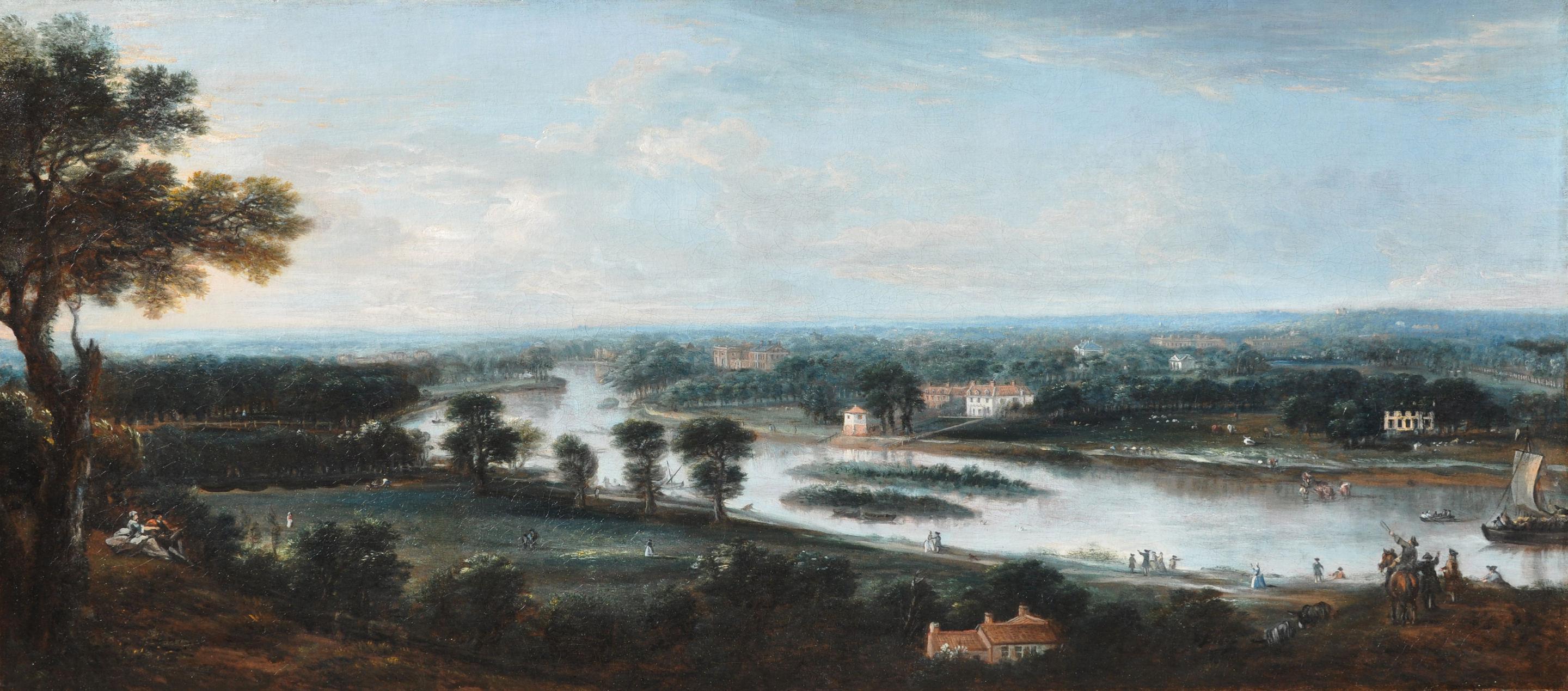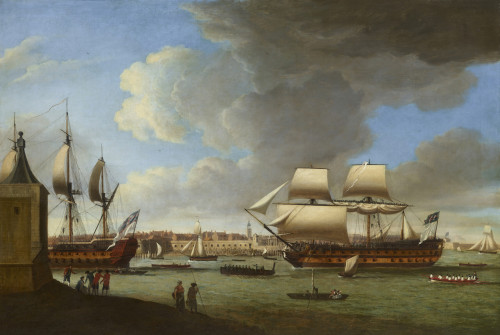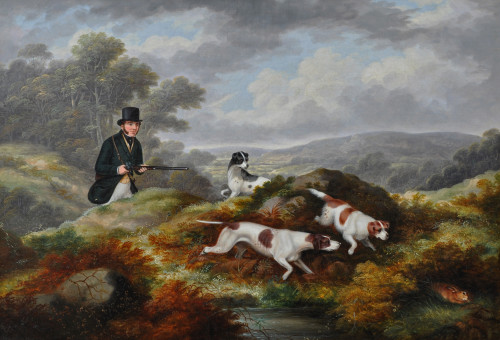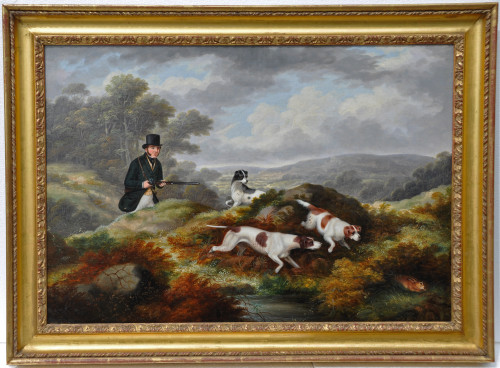A View from Richmond Hill; an English Arcadia
A View from Richmond Hill; an English Arcadia
John Wootton is probably most renowned for his sporting paintings, often of Newmarket, but he was also a landscapist of both topographical subjects and also in the classical tradition influenced by Gaspard Dughet and Claude Lorrain. He is important in the development of both English sporting and landscape painting in that he was a transitional artist who developed the Dutch style of portraying these subjects and imbued them with a softer and more English sensibility.
He was born in Snitterfield in Warwickshire in 1682 although some sources have given the date 1678. There is nothing known about his parents but tradition has it that when the 1st Duke of Beaufort's daughter, Lady Anne Somerset, married the future Earl of Coventry, she moved to Snitterfield House and the young John Wootton served as her page. It is thought that it was she who encouraged him to take up painting. Lady Anne and Wootton remained in touch for at least forty years and in one letter the artist asked that she become godmother to his children.
Wootton is thought to have been apprenticed for a time to the Flemish-born landscape painter Jan Siberechts in 1694. However, sometime in the late 1690s he had become apprenticed to Jan Wyck, who had come to England from Holland and established himself at the forefront of painting military scenes and landscape. The Beauforts and Coventrys were patrons of Wyck and it is probably through them that Wootton secured this important introduction, moving to study with him in Mortlake in Surrey.
After Wyck's death in 1702, Wootton moved to Newmarket where by 1714 he had established a significant reputation with the nobility for racing scenes on the Heath and horse portraiture. He had become a founder member of the Academy of Painting in 1711 and was also a member of the Society of Virtuosi of St Luke, becoming its Steward in 1717. This would have enabled him to see, and take an interest in, a wide range of artistic subjects and styles and in his commissioned work of painting the horses on the great estates, would have been able to study significant collections. Wootton was the first English painter of horse portraits and the Earl of Egremont proclaimed him to be "…the best horse painter in England", an opinion shared by the aristocracy who regarded him as the best available to record their hunters and racehorses. A good number of this portraiture was life-sized and when a work necessitated the inclusion of a human portrait, then this was usually done in conjunction with portrait specialists such as Jonathan Richardson, Charles Jervas, William Hogarth, Michael Dahl, William Hoare, Thomas Gibson and others. One example of this large format was the mounted portrait of George II which Queen Caroline came to see in the artist's studio which she declared to be "…a large noble painting room". In 1714 at Welbeck, the collection of the Duke of Portland in which the artist is well represented, Wootton is referred to as "…ye horse painter…" and he was well rewarded for his ability and commanded a high price, enabling him to ask £40 for a large piece which was a significant figure. He had the reputation among his artistic peers of being the best remunerated of all of them.
The hunting scenes which John Wootton produced display more of Jan Wyck's influence than do his equestrian portraits and are also stylistically similar to those of his friend Peter Tillemans. Wootton's importance in evolving English sporting painting in that he marked the transition from the Netherlandish style of painting to one that can be described as particularly English. He even utilised both styles in the same genre with Flemish style chargers, evident in his battle scenes, and English style racehorses. He was particularly adept at depicting landscape and the depth that skilful composition could imbue in the work. The large works which contained many figures and horses enhances this effect and gives life and movement and in this he far exceeded James Seymour whose landscape settings are rather cursory in comparison.
Wootton painted large, often vast, paintings of racing scenes, hunts and horses and it is for these that he has secured his reputation. His pure landscapes, as opposed to commissioned views of country houses or estates, are scarce and seemingly mostly produced for his own enjoyment as a diversion from his usual oeuvre. He did paint a number of romantic landscapes for clients, often with a classical leaning and these were influenced by the old master school with more sombre and umber tones which can be at variance with his brighter sporting works. These paintings come close to emulating Wootton's near contemporary George Lambert, probably the most renowned English-born landscape painter of that period who, together with Wootton and a few others, can almost be regarded as the founders of that tradition. One 19th century critic wrote that: "It is to be regretted that we do not know more of this man as a Landscape painter." Wootton was a significant contributor to the development of British landscape painting augmented by the fact that he had instructed Lambert, who became known as the "Father of the English landscape" who in turn was the main influence on Richard Wilson. It is interesting to note that in the 1744 list of the Stewards of the St Luke's Club Wootton is recorded as "Painter, Landskip." Arline Meyer writes that "While on many occasions Wootton both signed and dated his paintings, at other times he only signed them, and frequently he did neither.
Landscapes were of course an integral part of Wootton's sporting and battle scenes and the composition, with the topography and placement of trees and buildings, were carefully located in the construction of the painting to enhance the figures and animals. Some of his paintings of "prospects" reference the Netherlandish style of artists such as Jan Siberechts and Leonard Knyff who worked in England but other paintings were more in the emerging English style.
Wootton's early landscape style has displayed the influence of the English based Netherlandish artists such as Siberechts, Jan Wyck and Hendrik Dankerts who had come to England in the late 17th century following the accession of William of Orange and the ensuing enthusiasm for Dutch architecture and arts. Their depictions had been more closely aligned to an accurate topographical recording, particularly in some of the elevated prospects of country estates. Wootton forged a different path, which combined a recognisably topographical depiction with a more lyrical and classical composition. He, like his Netherlandish forbears, often used the elevated perspective but whereas the latter would have a large expanse of receding landscape, Wootton brings the viewer into the foreground with figures, animals or other points of interest and the scene evolves into the distance from there. His first pure landscape was A View from Box Hill painted in 1716. By 1720 his landscapes blend the classical 17th century Roman influence with the Northern European style and by 1722 he showed a marked tendency to work in Gaspard Dughet's style. Arline Meyer writes that this stylistic shift is not: "…a reflection of English landscape taste shifting away from descriptive views to idealisations of the Roman Campagna; Wootton clearly appreciated the classical pastoral form as the most adaptable to Augustan ideals. He worked in the manner of Gaspard Dughet precisely because he was alert to the stoic ideas which underlie his style."
In the early 1720s, the Duke of Beaufort had enabled him to travel to Rome to further his studies which had a significant effect on his style and inspiration on subject matter and George Vertue, in his Notebooks in the Walpole Society, records that in the period 1721-5 he started to show the influence of Gaspar Dughet and Claude: "Mr J Wootton has bravely distinguished himself in his late paintings of Landschape, very much like the pictures of Gaspar Poussin (Dughet), both as to invention design and Colouring, he having studied from several pieces of that masters painting, has perfectly entered into his manner."
Some have believed that Wootton only started to paint landscape subjects after his visit to Rome but indications are that this is not the case and the trip was more to hone his skill and broaden his horizons. Horace Walpole wrote in 1762 that at Shortgrove in Essex "…there are many landscapes over chimnies and doors by Wootton, but done when he was very young." Furthermore on his visit to Stourhead in the same year he observed: "…in the sky-light room…a landscape by Claud Lorrain - Its companion by Wootton, good." The palette that he utilised for some of the more classical landscapes was also sometimes at variance with how he usually painted and some of the pastoral subjects display much looser brushwork, somewhat reminiscent of Francesco Zuccarelli who had become popular in England when he worked there between 1752 and 1762.
By the mid-18th century, English taste had come to appreciate the light that was apparent in the works of Claude and Wootton translated this poetic luminescence into his paintings. In his pure landscape work he also moved away from classical motifs into depicting views of the Neapolitan coast which also referenced Claude but which were not slavish pastiches. He had been constantly busy producing sporting and animal paintings but with the increased interest in landscape painting in its own right and the taste for artists such as Salvator Rosa, Nicolas Poussin, Claude etc encountered on the increasingly popular Grand Tour, wealthy patrons would commission English artists to produce scenes that reminded them of their travels.
The way that Wootton painted English views also developed at this time with rich textures and more subtlety apparent with particular attention given to the way that he just touched dark pigments on the canvas with flecks of light paint on the brush to delineate the effect of light. The foliage of the trees also became less of a dense and sometimes sombre mass and more lace-like, further enhancing the lightness and sense of air.
It was in the 1740s, when Wootton produced some of his best pure landscapes, that he adapted the topographical features and perspectives to produce an aesthetically pleasing whole. He was certainly not the only 18th century artist to do this as Richard Wilson, another influenced by Claude, often adjusted the height of mountains or included trees or other features as counter-balances. In Wootton's country house paintings produced for the aristocracy and the gentry, the setting of the house in its landscaped gardens could be made ideal with a constructed harmonious relationship between the two. Whereas previously he had enlivened some prospect views with carefully placed groups of figures in the foreground, the figures in this period became more a part of the composition rather than a strong foreground feature. He produced several views around London at this time with paintings of Chiswick House, Cassiobury Park and View from Caenwood House over London. The British Museum has a drawing A View from Richmond Hill from the Star and Garter Inn.
Wootton gave up painting in 1761 due to failing eyesight and an auction was held at the auctioneer's house - Mr Langford - in the Great Piazza, Covent Garden over two days on 12th and 13th March. It was advertised as: The Genuine and Entire Collection of Pictures of Mr John Wootton, of Cavendish Square, Landscape Painter. The sale mostly comprised paintings by Wootton but there were also works by van der Neer, Ricci, Borgognone, Amigoni, da Cortona, Panini, Solomena, van de Velde, Claude, Monamy, Poussin, Giordano, Rubens, Teniers and Kneller among others.
A classical landscape was engraved by F. Vivares and a further two landscapes by J. Pye. His likeness can be perceived in the 1736 portrait by Gawen Hamilton of the Wootton family which also included his mother. This group portrait was at one time in Horace Walpole's collection at Strawberry Hill and there was also a Rysbrach bust of Wootton in the same collection
Examples of Wootton's paintings can be seen in Tate Britain ( which has ten works), the National Portrait Gallery, Manchester Art Gallery, Fitzwilliam, Ashmolean, Royal Collection (11 oils), National Museum of Wales in Cardiff, Castle Museum in Norwich, Watford Museum, National Army Museum, the Whitworth, York Museum, Birmingham Museum, Cannon Hall Museum, Government Art Collection, Walmer Castle, Boughton House, Courtauld Institute of Art, Royal Albert Memorial Museum, National Trust: Petworth House, Lodge Park and Sherborne Estate, Stourhead, Waddesdon Manor, Chirk Castle, Antony, Anglesey Abbey, Upton House, Clandon Park, Hartwell House, Wallington, Blickling Hall, Hanbury Hall, Knole. In America: Yale Center for British Art, Fine Art Museum of San Francisco, Denver Art Museum, Philadelphia Museum of Art, Huntingdon Library, Metropolitan Museum of Art. The Hermitage in St Petersburg.
We are grateful to Professor Arline Meyer for her help in cataloguing this painting.
Bibliography:
John Wootton: Landscapes and Sporting Art in Early Georgian England - Arline Meyer
British Landscape Painting of the 18th Century - Luke Hermann
Painting in Britain 1530-1790 - Ellis Waterhouse
Manners and Morals: Hogarth and British Painting 1700-1760 - Elizabeth Einberg
The Dictionary of British Equestrian Artists - Sally Mitchell
Dictionary of British Animal Painters - J C Wood
Dictionary of British 18th century Painters- Ellis Waterhouse
The Artist and the Country House - John Harris
British Landscape Painting - Michael Rosenthal
Dictionary of British Landscape Painters - M H Grant
Dictionary of British Sporting Painters - Sydney H Paviere
The area from Hampton to Kew had been one of quiet market gardens, orchards and villages by the river up until the time of the Tudors. However, with the transformation of the Manor of Shene into Richmond Palace (Henry VII renamed it after his Yorkshire home) and Hampton Court together with the requisite ancillary buildings to support them, its importance and desirability increased and members of the royal family and aristocratic families moved there also, building elegant and substantial homes. Interspersed with the natural woodland and water meadows, magnificent gardens and hunting parks were created and were connected by way of formal avenues of trees. By the time of the eighteenth century there had developed a concentration of influential people in this area, people who had power and the money to exercise it and this in turn attracted both skilled artisans to help realise the ambitions of this moneyed class as well as those who followed the liberal arts (in its more modern sense) such as philosophers, poets and writers. With the spectacular view looking west from the top of Richmond Hill, this confluence of ambition and aesthetics led to the area of the Thames from Chiswick to Twickenham to be seen as an English Arcadia to rival views in Italy.
Whereas Tudor and Stuart gardens had been rather geometric and formal, the new fashion of the 18th century was for a much more romantic creation where the natural landscape and garden, designed with a poetic and artistic sensibility, formed a harmonious whole. The consequence was the English Landscape Movement, which recreated the idea of Virgil's ancient Greece and an idyllic pastoral landscape, as a new Arcadia, and having radiated out across England, it became fashionable across much of Europe.
The prospect from Richmond Hill was a popular scene for commissioning aristocrats and courtiers to be depicted in paintings and it was initially the Dutch topographical painters such as Pieter Andreas Rysbrack the Younger, Peter Tillemans and Leonard Knyff who satisfied this demand, to be followed by Canaletto, Francesco Zuccarelli, Antonio Joli, Richard Wilson, William Marlow and then into the 19th century by such as George Hilditch, William Havell, Thomas Christopher Hofland and George Barret.
Writers such as the playwrights and poets Joseph Addison and James Thomson and the poet Alexander Pope, writers John Gay and Jonathan Swift (the three yahoos) the actor David Garrick and the politician and art historian Horace Walpole all resided there and espoused this classical pastoral ideal, perceiving a natural beauty in the landscape. Pope wrote that: "…no scenes of paradise, no happy bowers, equal to those on the banks of the Thames" and in a very early pastoral which referenced Virgil, he wrote:
"…First in these fields I try sylvan strains
Nor blush to sport on Windsor's blissful plains:
Fair Thames, flow gently from this sacred spring.
While on thy banks Sicilian Muses sing
Blest Thames's shores the brightest beauties yield
Feed here my lambs, I'' seek no distant field".
The garden designer William Kent was one of the originators of the English landscape garden and the garden of the Palladian villa Chiswick House, which was completed in 1729, was created by Kent and was one of the earliest examples of this new approach to the setting of a major house in its surroundings. He also worked on the gardens of Queen Caroline's residence at Richmond Lodge and those of Alexander Pope's villa at Twickenham. This was followed by Capability Brown's creation for the Duke of Northumberland's Syon House.
Dimensions:
1682 - 1764
Oil on canvas
England
RELATED ITEMS
























